MÉNILMONTANT - The rural village of Paris
On top of a hill in the northeastern end of Paris you’ll the small neighborhood of Ménilmontant. It has no well-known landmarks, famous buildings or historic battlefields. Instead, Ménilmontant is a neighborhood dominated by cozy cafés, packed restaurants, small craft shops, delicatessens, galleries and open studios.
Even though you're in the middle of the ever-flowing metropolis, you’ll find a village-like atmosphere. This is partly because Ménilmontant was in fact a rural village only incorporated into Paris in 1860. Fortunately, the village's winding cobbled streets, small squares and green islands were preserved and they define the neighborhood to this day.
With this guide, Kaufmann Journal gives you an introduction to what you can experience in and around the Ménilmontant neighborhood – a neighbourhood that is so quintessentially Parisian and yet stands out.
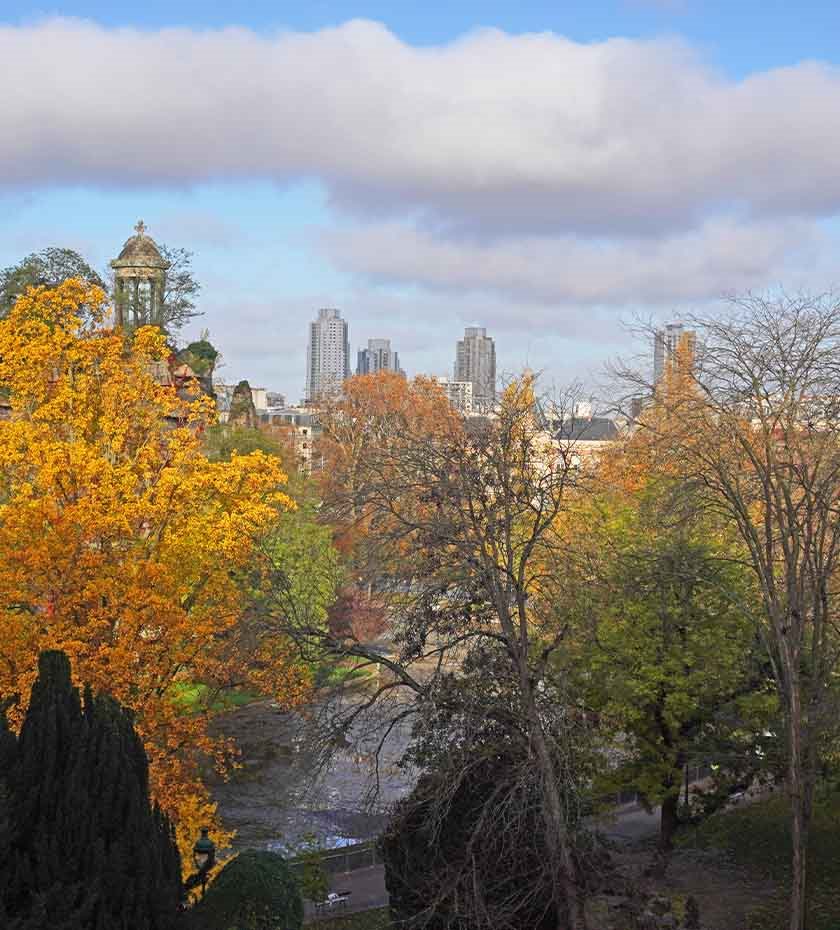
The park: Buttes-Chaumont
Many Parisians refer to Parc des Buttes-Chaumont as their favorite park, and for good reason. Unlike so many of the city's parks, Parc des Buttes-Chaumont has open green spaces that in the summer months are a mosaic of picnic blankets, birthday celebrations, lone sunbathers, children playing, families, couples and groups of friends.
Because the park is located on top of a hill, it provides a variety of beautiful views of the city. For example, you can position your picnic blanket so that you have a direct view of the Sacré Coeur church between the treetops.
The Parc des Buttes-Chaumont is particular because it was built from scratch as part of the 1867 Paris World's Fair and designed as a celebration of all of France's landscapes. Walking through the park is therefore an experience of passing through the entire country's vegetation and geology: you’ll find cliffs like those of Étretat, alpine meadows and Mediterranean groves, alongside both common and exotic trees such as honey hazel, ginkgo biloba, Siberian elm and Lebanese cedar. This highly artistic mix of vegetation reaches its peak towards the end of the year, when each tree offers its own unique take on the colors of autumn.
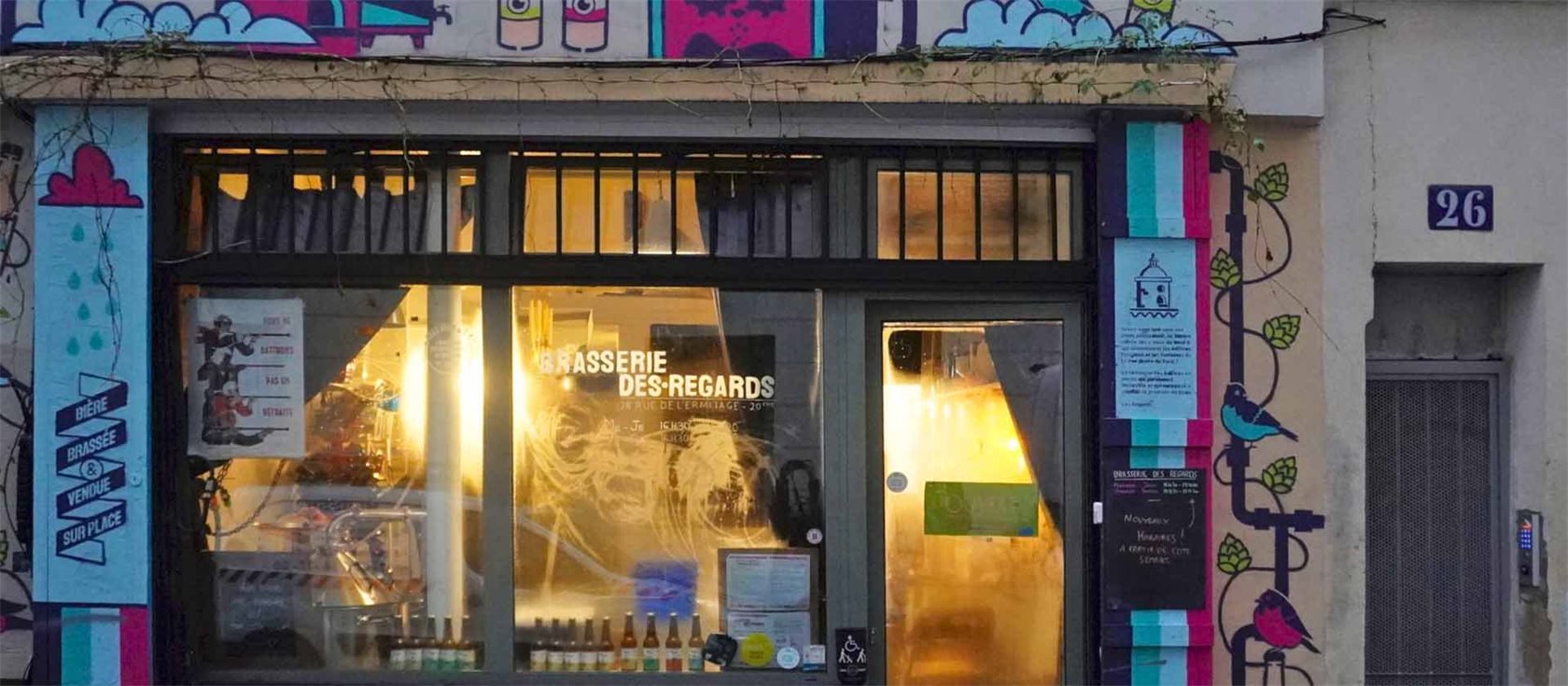
A true Parisian beer
In a winding street, the microbrewery Brasserie des Regards glows in the beginning twilight. As I enter the shop on this late November afternoon, I'm immediately greeted by the spicy smell of beer brewing. The 35 m2 shop also functions as brewery space and almost every square meter is occupied by metal barrels, bottles and hoses. As the assistant explains the different beers to me, he is interrupted by a faint beep and excuses himself briefly to attend to one of the many devices.
The brewery only makes 600-900 beers a month in five flavors, the most special of which is made with hops picked right here in Paris. "That's why the taste changes with the season," the clerk concludes his explanation.
The brewery is created and run by two friends, Romain and Cyril, who have both chosen brewing as a lifestyle. "The idea is not to grow, but to remain a small entity to avoid division of labor and loss of meaning," they state. The goal is to create local products, be responsible to the environment and form a meeting point for neighborhood beer enthusiasts, who, among other tasks, are welcome to participate in the care of the hop garden.
PRICE: 3-3,5 € PER BOTTLE
BRASSERIE DES REGARDS, 28 RUE DE L'ERMITAGE
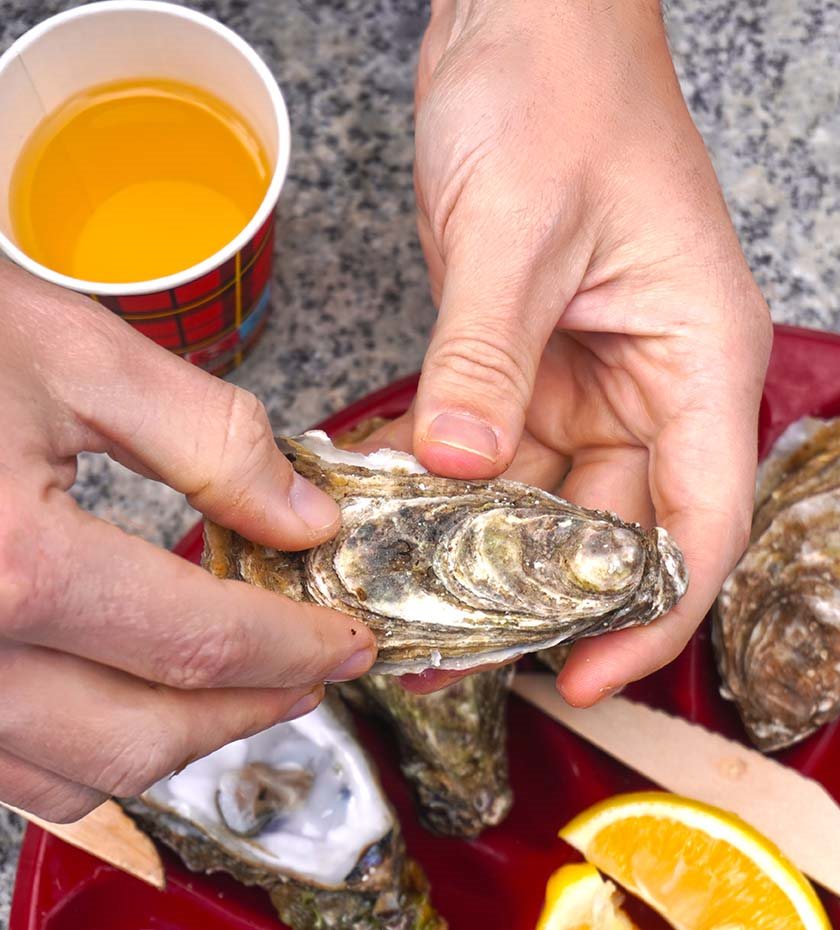
Oyster tasting
Every Sunday, the squares of Paris burst into colorful food markets and the streets fill with Parisians pulling their little wheeled shopping bags called pousettes. In the northern end of Ménilmontant, you'll find one such classic food market around Square Monseigneur Maillet.
This market offers a wide variety of seafood, vegetables and fruits, butchery and cheeses. But what makes this market stand out is its large selection of oysters.
On Sunday mornings, people crowd around the oyster stall where you can get, for example, twelve fines de claires for €8. Some buy the oysters to take home, but most have them opened and served on the spot with a glass of cold white wine in a paper cup.
You can eat at the narrow bar tables or take your tray of oysters out into the sun on Place des Fêtes, which borders the market. Regulars show up alone, buy 24 oysters of different varieties and pull out bread and freshly churned butter that they've just bought from the neighbor stall.
EXAMPLE PRICE: 12 FINES DE CLAIRES FOR €8
16 RUE AUGUSTIN THIERRY
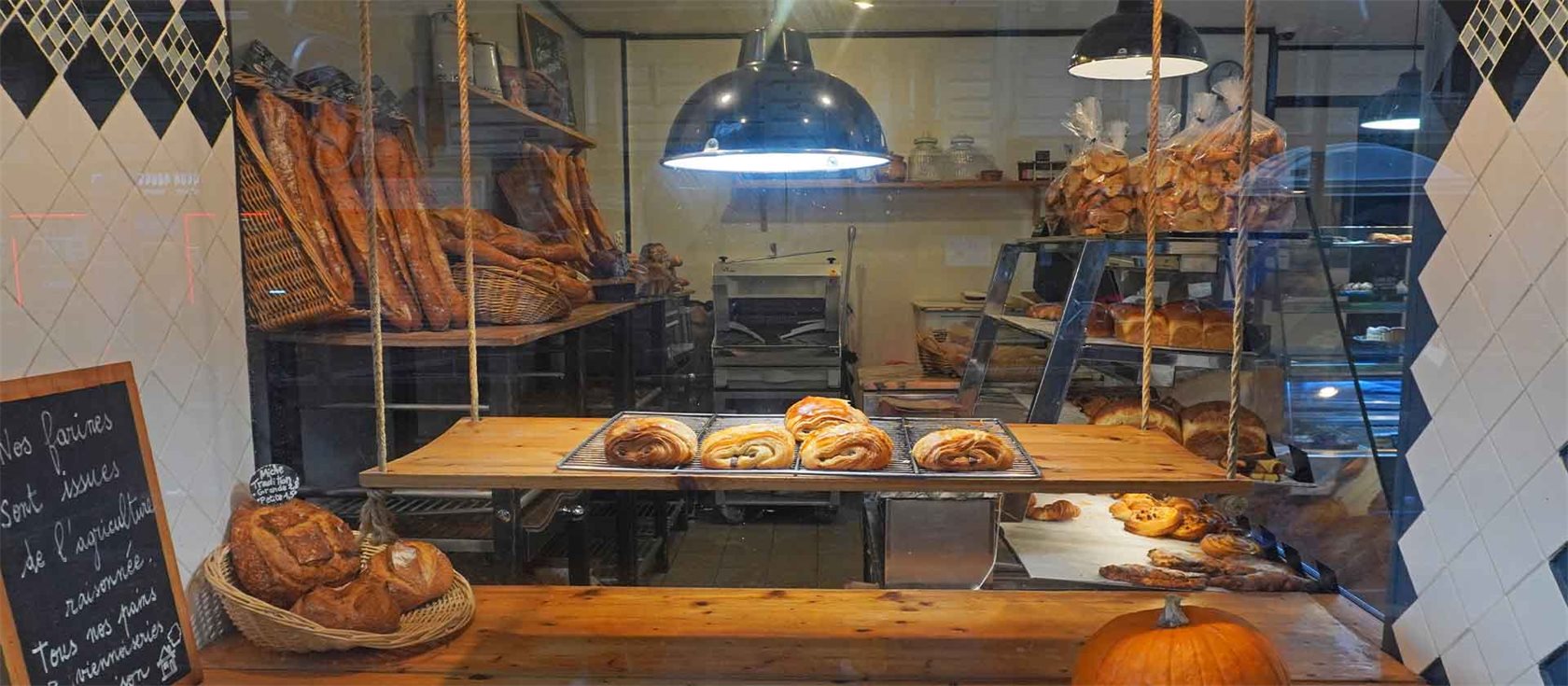
An extraordinary croissant
If you walk past the bakery Les Saveurs D'Orees and see croissants displayed on the window’s floating display table, you know you’ve come at the right moment. Often, the window is empty. It's only when the croissants are freshly baked that they are displayed - and then a queue quickly forms for these particularly delicious, particularly buttery and still warm croissants.
PRICE: 1,20 €.
LES SAVEURS D'OREES,
304 RUE DES PYRÉNÉES
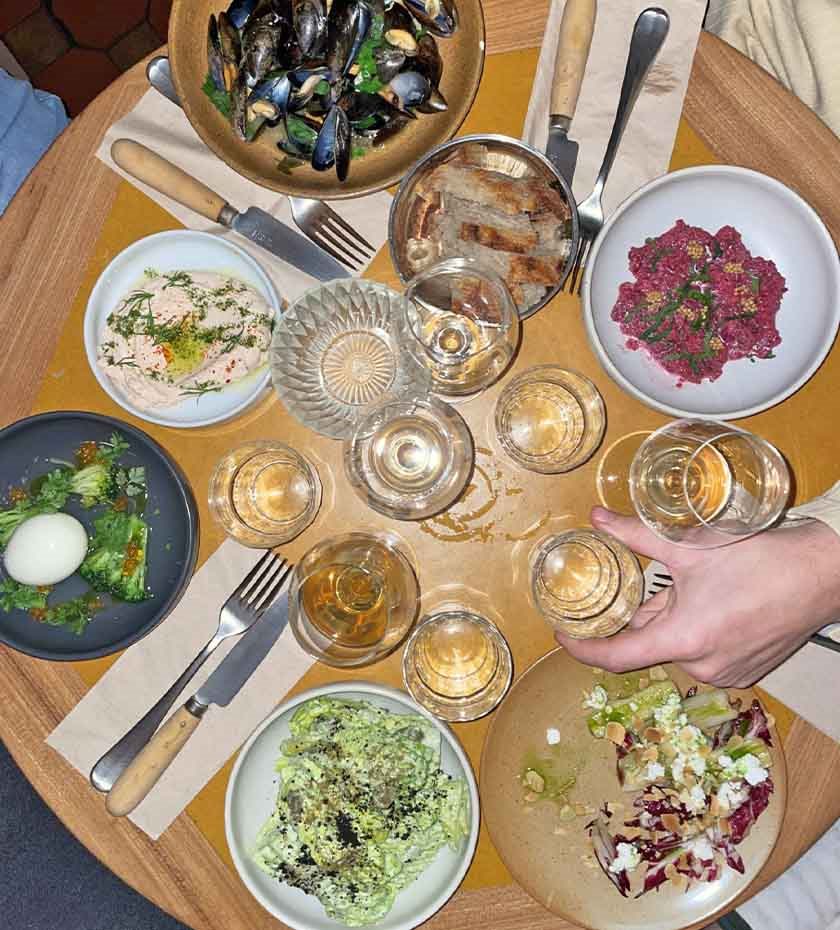
Restaurant Paloma
Paloma is an almost new restaurant that still manages to encapsulate the charm of the neighborhood. The atmosphere is lively and the prices are low, but what really draws the neighbors in is the beauty and care put into the decor and each individual serving.
Paloma was created by two friends, Marie-Anne and Olivia, who met at art school in Paris. After graduating, they retrained as chef and carpenter respectively, and during the lockdown, they built their own restaurant from scratch. Everything from the kitchen to the tables and tiling is the friends' own creation, and the result is a cozy and aesthetic meeting of raw brick and hexagonal tiles, green plants and bistro furniture, large mirrors and an open kitchen.
Today, Marie-Anne and Olivia run both the kitchen and the service. The evening menu consists of a series of French and Catalan-inspired, shareable tapas dishes. On my last visit, they included crowd favorite duck tataki with coriander and sesame, as well as beetroot tartare with herring and shiso, grilled octopus made with juice from morteau sausages and black risotto with scallops and mushrooms. Their most popular dessert is a Baba au Rhum served with a moat of rum and star anise syrup as well as a twisted tower of whipped cream.
PRICE: TWO-COURSE LUNCH MENU FOR €16, EVENING TAPAS €6-13 PER COURSE.
PALOMA, 93 RUE JULIEN LACROIX
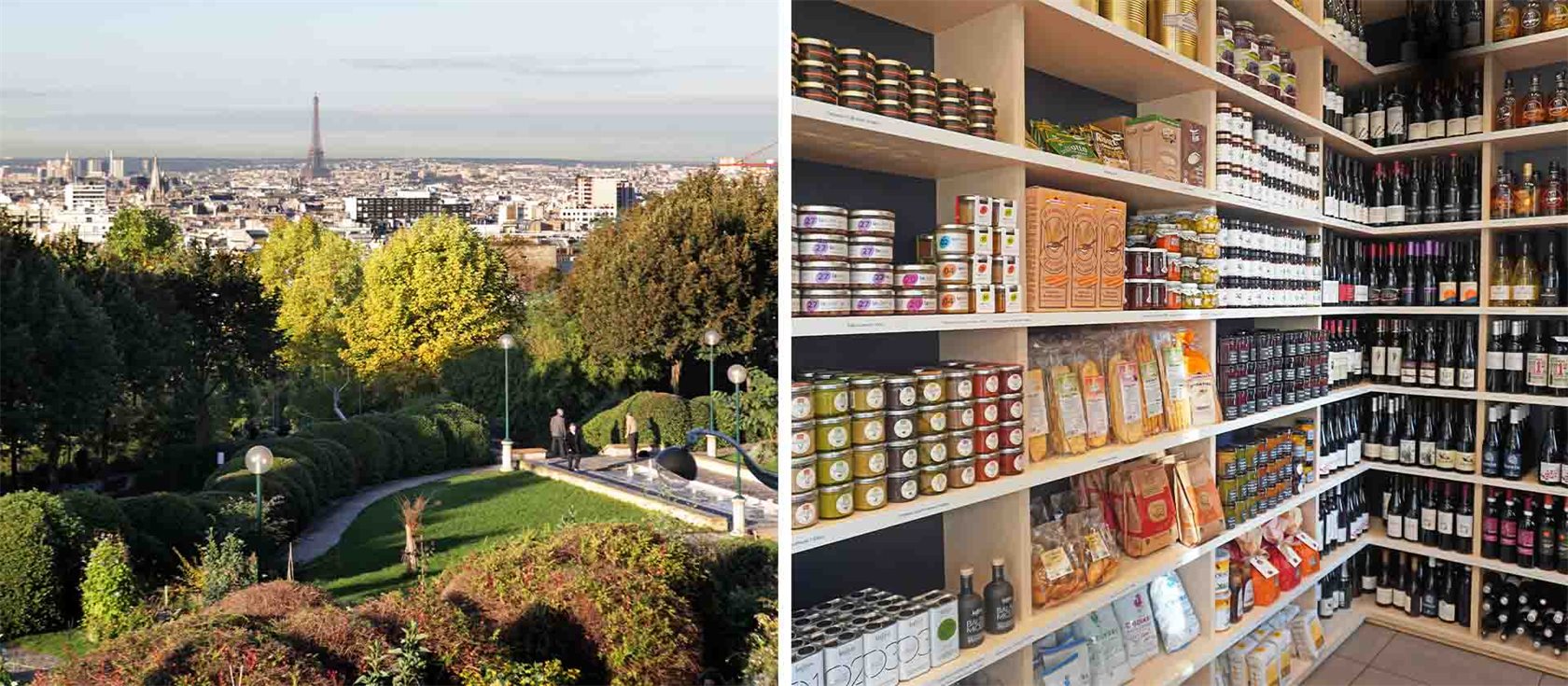
A view of Paris
At the top of Parc de Belleville, a parc so steep that its lawns and beds are laid in stairs, you’ll find a terrace, where couples and teenagers group after dark. Every time the clock strikes the hour, they watch the Eiffel Tower glimmer like a diamond in the middle of the city's sea of light.
From here you also have a great view of other architectural landmarks such as the Montparnasse Tower and the Panthéon Church. The Belvédère de Belleville, as the terrace is called, is therefore a great alternative to the more well-known – and therefore more touristy - viewpoint at the Sacré Coeur church on the neighboring hill of Montmartre.
BELVÉDÈRE DE BELLEVILLE,
27 RUE PIAT.
THE EIFFEL TOWER FLASHES IN THE EVENING FOR FIVE MINUTES EVERY TIME THE CLOCK STRIKES THE HOUR.
French delicacies
Ménilmontant has no shortage of specialized delicatessens. You'll discover several streets lined with a fish shop, a cheese shop, a greengrocer, a wine shop, a charcuterie, and so on. But if you're looking for some of the more durable French delicacies to bring with you home, Apertivus is a good bet. Here they specialize in wine, preserves and dried sausages - as well as hot lunch dishes to go. Especially their selection of canned food is worth exploring. Try, for example, their duck rillette, quail pâté or fig jam.
APERTIVUS, 117 RUE DE BELLEVILLE
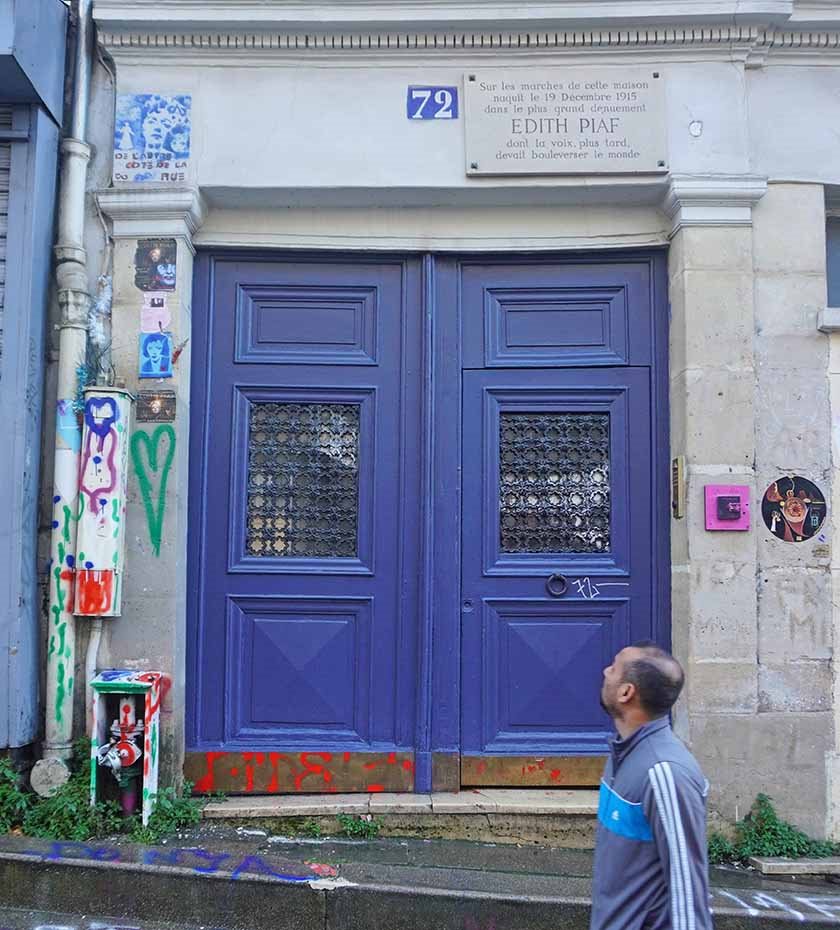
The birthplace of Edith Piaf
The birthplace of Edith Piaf Today, Ménilmontant is a bustling neighborhood full of cozy cafés, small specialty shops and well-dressed young families, but we don't have to go back many decades before it looked very different.
In the old days, when the big factories were located in the middle of Paris and emitted their thick, black smoke, this smoke usually flowed north and polluted the air in the northern neighborhoods. This is one of the reasons why southern Paris was and is dominated by upscale neighborhoods, while the neighborhoods to the north, such as Ménilmontant and the neighboring Belleville, were populated by working class people living in close quarters and in poor conditions.
Right here in the middle of this raw and impoverished street life, singer Edith Piaf was born. Now 60 years after her death, she is still celebrated as the neighborhood's muse, and her hit songs like La vie en rose and Non, je ne regrette rien have become classics that many associate with the very spirit of Paris. The songs are both sweet and warm, but also have a deep melancholy that reminds us that life isn't always easy – as Edith Piaf herself only knew too well.
Up until the end of the 20th century, the neighborhood remained harsh and known for its neglected apartments. But then something changed: artists and young entrepreneurs started moving in because of the cheap price per square meter. With them came capital and with it the studios, small galleries, high-end specialty shops and cozy apartments that the neighborhood is known for today.
There aren't many signs left of the neighborhood's colorful past and the people who used to live here. But if you look closely on the steep Rue de Belleville, which runs along the west side of Ménilmontant, you can find a modest plaque above the gate of no. 72 with the inscription: "On the steps of this house, Edith Piaf was born on December 19,1915, in the greatest possible poverty. Later her voice would make the world shake."
It may be healthy to be reminded that a relatively short time ago, things were so harsh in this now so pleasant place that someone, out of sheer poverty, had to give birth under a lamppost. What remains is an inscription, a photograph of Edith Piaf and a small music box on the front of the house. When you turn it with your fingers, it plays the theme from La vie en rose: Je vois la vie en rose. I see life in a shade of rose.
MEMORIAL PLAQUE FOR SINGER EDITH PIAF 72 RUE DE BELLEVILLE